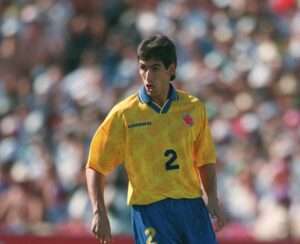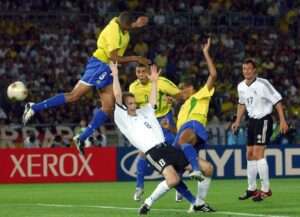A Key Component of Defending
The position where a player is most commonly required to make a defensive header is center-back. However, even a striker may be called upon to do so, if he is back defending a corner for instance. So it is important that whatever position you play in, the art of defensive heading is mastered.
Very young players (and some older ones!) can be reluctant to head the ball for fear of getting hurt. They will often close their eyes and let it land on their head, rather than attacking the ball.
It is therefore helpful, if you are teaching a youngster how to head, to practice with a soft ball at first.
Most defensive headers are performed with the aid of a jump, but if unopposed, they can be made from a standing position.
This step-by-step guide shows you how to perform the classic defensive header when jumping.
The Run Up
When making a defensive header, you will either be going up to head the ball on your own, or you may be up against one or more opponents.
When the ball is up in the air, and is set to come in your direction, you need to move into the line of the ball. You must position yourself close to where you think it is going to end up so you are right on the ball when heading it and can get good direction.
You need to undertake a run up to the ball in order to get in line, and also apply power to the header.
Take Off
Having got a good run up, you now need to take off, off one foot, as the ball approaches, using the arms for elevation.
Ideally you want one foot in front and one foot back in order to keep your balance.
Use Your Arms
When in mid-flight, you need to have your arms up for balance and to protect yourself as you jump. You need to hold your arms up to try and pull yourself forward to create power on the ball.
Players must be careful if they are going up for a header with an opponent because flailing arms can lead to a foul being conceded if the referee deems that you have made sufficient contact with an opponent to blow the whistle.
When you are defending, you usually want to head the ball as high up in the air and as far away as possible. Leap up, body arched and back ready to give power to the neck.
Making Contact
You need to concentrate on the ball and making contact with your forehead on the middle of the front part.
You need to head the ball above the eyeline and below the hairline.
The better the contact, the further and more forcefully it will travel. Power your neck forward to allow the forehead to strike the ball.
Make contact with the ball at the highest point of the jump to get the most height and distance.
It is important not to make contact with the ball with the top of your head as this could hurt.
Distance
You must look to get good distance on the ball.
After making contact with the ball, you must try to land on both feet, to avoid falling awkwardly.






